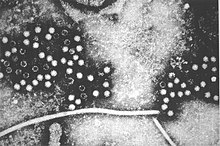Hepatitis E virus
| Hepatitis E virus | |
|---|---|
 |
|
| TEM micrograph of hepatitis E virions. | |
| Virus classification | |
| Group: | Group IV ((+)ssRNA) |
| Order: | Unassigned |
| Family: | Hepeviridae |
| Genus: | Orthohepevirus |
| Species: | Orthohepevirus A |
| Synonyms | |
|
|
The Hepatitis E virus, or HEV, is the causative agent of Hepatitis E. Its taxonomic name is Orthohepevirus A.
The global burden of infections from the two major genotypes (1 and 2) is estimated at 20 million per year, leading to 70,000 deaths and 3,000 stillbirths.
The virus particle was first visualised in 1983 but was only molecularly cloned in 1990.
HEV can be classified into four different genotypes from different geographical regions: genotype 1 (Asia), genotype 2 (Africa and Mexico), genotype 3 (Europe and North America) and genotype 4 (Asia).
The viral genome a single-strand of positive-sense RNA that is approximately 7200 bases in length. It encodes 3 proteins (O1, O2, O3), two of which are polyproteins, that is, they are cleaved into fragments which carry out the actual functions of the virus (see figure). The O1 protein consists of 7 such fragments, namely Met (Methyltransferase), Y (Y-domain), Plp (Papain like protease), V (proline-rich variable region), X (X-domain, macro-domain), Hel (Helicase), and Rdrp (RNA dependent RNA polymerase). The Pvx domain is a fusion protein consisting of the Plp, V and X domains. The O3 protein is encoded by a single open reading frame (ORF3). The O2 protein encodes the capsid, which is composed of 3 domains, namely the shell domain (S) and two protruding domains (P1, P2). Numbers in the figure indicate positions in the RNA sequence.
The protein-protein Interactome among HEV proteins has been mapped by Osterman et al. (2015) who found 25 interactions among the 10 proteins studied. 24 of these interactions were considered as of "high quality".
The viral particles are 27 to 34 nanometers in diameter and are non-enveloped.
It was previously classified in the Caliciviridae family. However, its genome more closely resembles the rubella virus. It is now classified as a member of the genus Orthohepevirus in the Hepeviridae family.
...
Wikipedia

